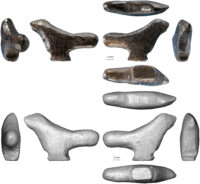 A tiny songbird carved 13,500 years ago in China is the oldest figurine ever discovered in East Asia. It’s the oldest three-dimensional art in the region by 8,500 years, albeit not the earliest carved art overall since there are engravings on bone and stone and some worked ornaments made of animal teeth and shell that predate the bird.
A tiny songbird carved 13,500 years ago in China is the oldest figurine ever discovered in East Asia. It’s the oldest three-dimensional art in the region by 8,500 years, albeit not the earliest carved art overall since there are engravings on bone and stone and some worked ornaments made of animal teeth and shell that predate the bird.
The burned bone figurine was discovered in Lingjing, Henan Province, central China, at a prehistoric site with 11 layers ranging in date from 118,000 years ago (number 11) to the Bronze Age (number 1). Seven of the layers contain archaeological materials. The bird was not found in its original stratigraphic context, however. It was in a refuse pile where it was dumped when a well was dug there in 1958. Most of the fifth layer was stripped and dumped during the operation. Thankfully the pile remained intact, allowing archaeologists excavating the site to explore the spoil heap during the 2008 and 2013 campaigns. They found chert flakes, pottery sherds, animal remains, ostrich shell fragments, charcoal and the bird figurine.
The wee bird is just six tenths of an inch long and two tenths of an inch wide. Its short head and neck, rounded bill, short legs and long tail suggest it represents a bird of the Passeriformes order. Researchers were able to estimate its age by dating burned bone samples found with it, including one that was gouged using the same technique used to carve the bird.
[University of Bordeaux researcher Francesco] D’Errico said the bird was “exceptionally” well preserved, enabling researchers to trace the various carving methods used to create different parts of the figure, including gouging with a stone tool, scraping and polishing.
“Our observations show that the artist knew well which technique was the more adapted to carve the different parts of the animal,” he said.
“What is also remarkable is that the carving is not a fully realistic representation of a bird,” he said.
The figurine has an oversized tail, allowing it to balance on its pedestal.
“Without this trick the bird would fall on its head,” D’Errico said, adding that this shows the carving is not just a “casual experiment.”
The authors said that the craftsmanship suggests the advanced stage of an artistic tradition, which began much earlier.
The find has been published in the journal PLOS One.